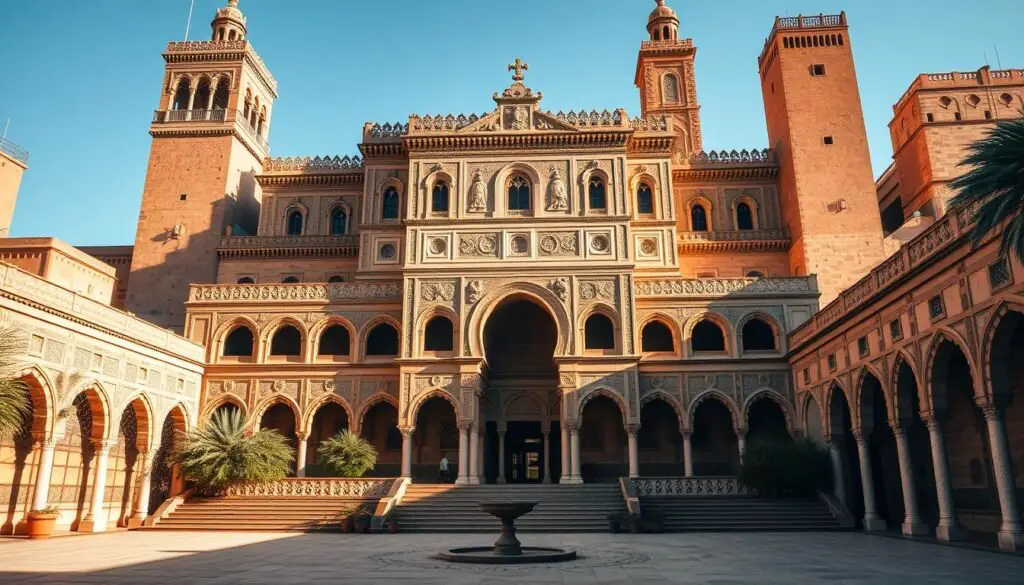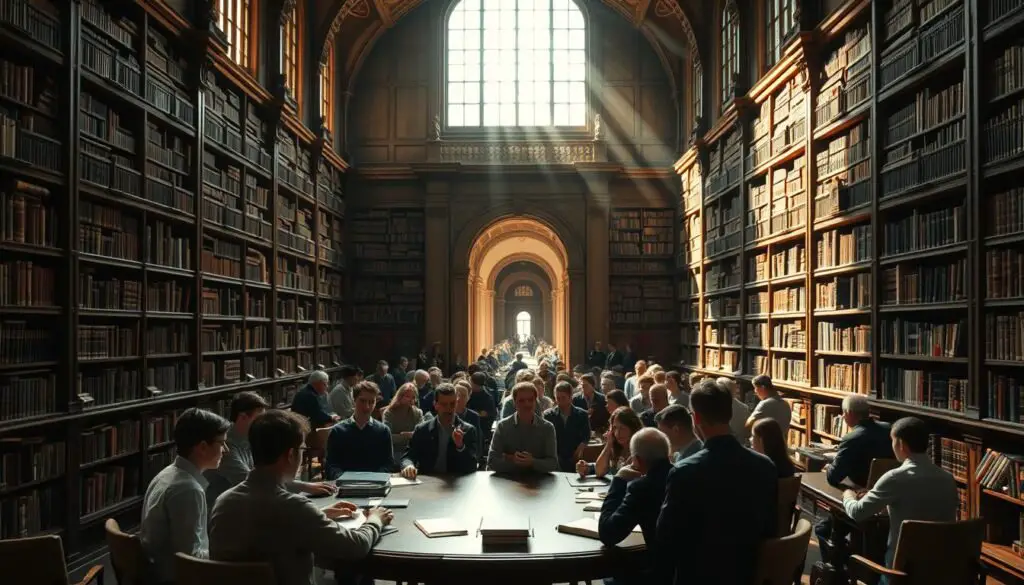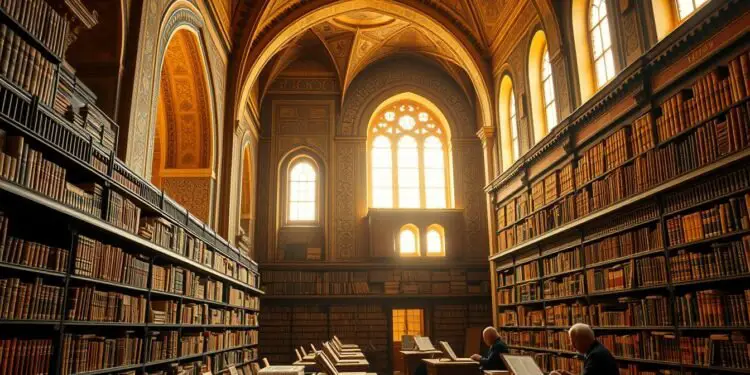What if the oldest continually operating learning hub wasn’t in Europe but in the heart of Morocco? Founded in 859 CE by Fatima al-Fihri, this legendary institution holds a Guinness World Records title as the world’s oldest degree-granting university. Its rich legacy spans over a millennium, blending Islamic scholarship with modern academia.
Recognized by UNESCO, the site began as a mosque and evolved into a thriving center of knowledge. Today, it houses rare treasures like Ibn Khaldun’s manuscripts and 9th-century Quranic texts. Its 1963 transformation into a state university bridged ancient traditions with contemporary education.
Key Takeaways
- Founded in 859 CE, it’s the oldest operating higher learning institution globally.
- Earned Guinness World Records and UNESCO recognition for its historic role.
- Originally a mosque, it became a modern university in 1963.
- Home to priceless manuscripts, including works by Ibn Khaldun.
- A symbol of the Islamic Golden Age’s intellectual legacy.
The Founding of Al Qarawiyyin University of Fes
A Tunisian woman’s vision in 9th-century Morocco laid the foundation for a millennium of learning. Fatima al-Fihri, a scholar and philanthropist, transformed her father’s merchant wealth into an enduring legacy. Her story began in the bustling city of Fes, where faith and knowledge intertwined.
Fatima al-Fihri: The Visionary Founder
Born in Tunisia, Fatima migrated to Fes with her family. After her father passed, she used his inheritance to build a mosque as a pious endowment. Construction spanned two years (857–859 CE), creating a hub for prayer and study.
Historical debates linger. A 877 CE inscription credits Idrisid prince Dawud ibn Idris, but Fatima’s role remains central. Her dedication shaped a space where teaching circles grew into formal education.
The Mosque That Became a University
Originally 30 square meters, the mosque expanded under Almoravid rule to 3,000 square meters. Its growth mirrored its scholarly influence. Nearby, Fatima’s sister Mariam founded Al-Andalusiyyin Mosque, creating a twin legacy of learning.
From communal prayers to structured classes, the site evolved organically. By the 12th century, it was a beacon of Islamic scholarship—proving that great institutions often start humbly.
A Legacy of Learning: The Oldest Operating University
Long before Oxford or Bologna, a groundbreaking center of learning emerged in North Africa. Its endurance challenges conventional narratives about the origins of higher education.

Recognition by UNESCO and Guinness World Records
In 1987, UNESCO designated this institution as the oldest existing educational hub. The Guinness World Records later cemented its title, citing uninterrupted operation since 859 CE.
Unlike medieval European models, it blended religious and secular studies. Astronomy, medicine, and logic were taught alongside Islamic jurisprudence, reflecting a holistic approach.
Debates Over Its “University” Status
Scholars debate whether it functioned as a traditional madrasa before 1963 reforms. European institutions often required formal charters, while this site evolved organically from mosque classes.
The 1963 reorganization modernized its structure, aligning it with state university standards. Yet, its library—home to Ibn Khaldun’s manuscripts—remains a testament to its scholarly legacy.
Architectural Marvel of the Islamic Golden Age
Centuries-old craftsmanship meets intellectual legacy in this historic landmark. Its walls whisper tales of dynasties, scholars, and artisans who shaped its evolution. From intricate tilework to towering minarets, every detail reflects a golden era of Islamic art and science.
The Mosque’s Expansions and Design
The Almoravid dynasty transformed the site in the 12th century. They added the iconic square minaret, a symbol of Moroccan-Islamic identity. Horseshoe arches and carved stucco framed its grand prayer halls.
Courtyards bloomed with zellij tilework—geometric patterns in cobalt and emerald. Andalusian influences blended with local styles, creating a visual harmony. The mosque even standardized call-to-prayer times across Fes.
The Iconic Library and Its Priceless Manuscripts
In 1349, Marinid Sultan Abu Inan Faris founded the library. It became a sanctuary for 4,000+ manuscripts. Among them: Ibn Khaldun’s Al-‘Ibar, a 9th-century Quran, and medical diplomas from 1207 CE.
The 14th-century water clock and gazelle-parchment texts highlight its innovation. Today, the library remains a bridge between past and present, preserving wisdom for future generations.
Curriculum and Academic Influence
Knowledge thrived here long before modern classrooms existed, blending faith with groundbreaking discoveries. The institution’s curriculum balanced religious studies with secular sciences, creating a model for holistic education.

Traditional Islamic Sciences and Beyond
Classical Arabic and Maliki jurisprudence formed the core. Students mastered Quranic exegesis alongside mathematics and astronomy. By the 12th century, medicine and philosophy joined the syllabus.
The 1788 reforms trimmed “unorthodox” subjects like Sufi metaphysics. Yet, the library preserved texts on logic and music—proof of its intellectual diversity.
Notable Scholars and Global Impact
Legendary scholars like Ibn Rushd (Averroes) and cartographer Al-Idrisi walked these halls. Their works bridged the Muslim world and Europe, influencing Renaissance thinkers.
European linguists like Golius studied here, while Ibn Khaldun’s manuscripts still draw researchers. The disputed ties to Pope Sylvester II hint at its far-reaching legacy.
The Transformation Into a Modern University
Modernization met tradition when colonial and post-independence reforms transformed this historic center of learning. The 20th century reshaped its identity, blending ancient scholarship with contemporary academic standards.
From Madrasa to State Institution
Under the French Protectorate (1914–1947), structured calendars and faculty salaries replaced informal teaching circles. The student body grew, with women admitted in the 1940s—a landmark shift.
Post-independence, a 1963 decree integrated the institution into Morocco’s national university system. New campuses in Marrakech and Agadir decentralized its reach, moving beyond Fes.
Reforms Under French Protectorate and Independence
Colonial administrators standardized curricula, while nationalist leaders—many alumni—pushed for autonomy. By 1965, reed mats yielded to modern classrooms, and politics joined traditional Islamic studies.
King Hassan II revived classical education in 1988, ensuring its legacy endured within the new system. Today, it balances ancient manuscripts with solar-paneled libraries—a testament to adaptation.
Al Qarawiyyin’s Role in Moroccan Culture
From anti-colonial protests to feminist milestones, this historic place mirrors Morocco’s journey. Its walls echo tales of resilience, shaping the city of Fez into a UNESCO-listed gem. For over a millennium, it has bridged tradition and progress.
Symbol of National Identity
During the 1930 Berber Dahir protests, the institution became a rallying point against French policies. Its courtyards hosted debates that fueled Morocco’s fight for national identity.
Today, its architecture stands as a testament to the time-honored blend of Andalusian and Moroccan artistry. The library’s manuscripts, like Ibn Khaldun’s works, remain cultural treasures.
Women’s Education and Social Progress
Fatima al-Fihri’s legacy as a founder paved the way for women’s education. By the 1940s, female students enrolled, breaking barriers in Islamic academia.
Modern reforms introduced French and English courses, ensuring relevance. Annual festivals now celebrate this dual heritage—honoring the past while embracing the future.
Visiting Al Qarawiyyin Today
Step into a living monument where history whispers through ancient arches and priceless manuscripts. This UNESCO-recognized place welcomes visitors daily, though access to certain areas like the prayer hall remains restricted to Muslims.
What to See: Mosque, Library, and Courtyards
Non-Muslim guests can explore the 14th-century library and Marinid-era courtyards for a 20 MAD fee (≈$2). The structure dazzles with carved cedar mihrabs and zellij mosaics—geometric tiles in vibrant blues and greens.
Highlights include the water clock courtyard and the world’s oldest surviving Quran. Nearby rooftops offer panoramic medina views, perfect for photographing the iconic minaret.
Preservation Efforts and Public Access
Architect Aziza Chaouni led 2016 preservation efforts, modernizing climate control for delicate manuscripts. Tourism revenue funds ongoing restorations, ensuring this 1,165-year-old site thrives for future generations.
Dress modestly (covered shoulders/knees) and visit between 9 AM-5 PM. Combine your trip with the Al-Attarine Madrasa or Chouara Tannery—both within walking distance.
Conclusion
For over twelve centuries, this legendary institution has shaped the world of learning. It stands as both a historic mosque and a modern academic hub, blending tradition with progress.
Its influence spans continents—from medieval scholars to today’s global studies. Visitors to Fez can witness its architectural splendor and cultural depth firsthand.
More than a landmark, it’s a testament to intellectual endurance. A living bridge between past and future, inspiring generations to seek knowledge.
FAQ
Who founded Al Qarawiyyin University of Fes?
A: Fatima al-Fihri, a devout Muslim woman, established the institution in 859 CE as a mosque and later expanded it into a center of learning.
Is Al Qarawiyyin recognized as the oldest university in the world?
Yes, Guinness World Records and UNESCO acknowledge it as the oldest continually operating degree-granting institution.
What subjects were originally taught there?
Early studies focused on Islamic jurisprudence, theology, and Arabic grammar, later expanding to mathematics, astronomy, and medicine.
Can visitors explore the historic library?
Yes, the ancient library houses rare manuscripts and is open to scholars and tourists, though some areas require special permission.
How did the institution evolve into a modern university?
Reforms during the French Protectorate and post-independence Morocco integrated secular studies while preserving its traditional curriculum.
What makes the mosque’s architecture significant?
Its design reflects Moroccan-Andalusian craftsmanship, with intricate tilework, carved wood, and one of the oldest minarets in North Africa.
Did women study at Al Qarawiyyin historically?
While early education was male-dominated, Fatima al-Fihri’s legacy inspired gradual inclusion, with women now forming part of the student body.
How does the university impact Moroccan identity today?
It remains a symbol of intellectual heritage, blending Islamic scholarship with contemporary education to shape national culture.




